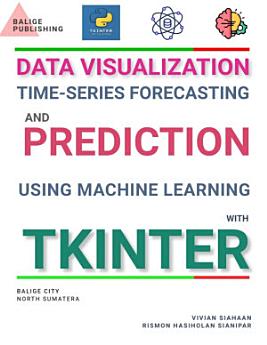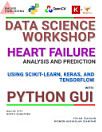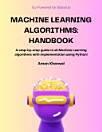DATA VISUALIZATION, TIME-SERIES FORECASTING, AND PREDICTION USING MACHINE LEARNING WITH TKINTER
About this ebook
The project begins with data visualization, where historical bitcoin market data is visually represented using various plots and charts. This provides users with an intuitive understanding of the data's trends, patterns, and fluctuations. Features distribution analysis is conducted to assess the statistical properties of the dataset, helping users identify key characteristics that may impact forecasting and prediction.
One of the project's core functionalities is time-series forecasting. Through a user-friendly interface built with Tkinter, users can select a stock symbol and specify the time horizon for forecasting. The project supports multiple machine learning regressors, such as Linear Regression, Decision Trees, Random Forests, Gradient Boosting, Extreme Gradient Boosting, Multi-Layer Perceptron, Lasso, Ridge, AdaBoost, and KNN, allowing users to choose the most suitable algorithm for their forecasting needs. Time-series forecasting is crucial for making predictions about stock prices, which is essential for investment strategies.
The project employs various machine learning regressors to predict the adjusted closing price of bitcoin stock. By training these models on historical data, users can obtain predictions for future adjusted closing prices. This information is invaluable for traders and investors looking to make buy or sell decisions. The project also incorporates hyperparameter tuning and cross-validation to enhance the accuracy of these predictions.
These models employ metrics such as Mean Absolute Error (MAE), which quantifies the average absolute discrepancy between predicted values and actual values. Lower MAE values signify superior model performance. Additionally, Mean Squared Error (MSE) is used to calculate the average squared differences between predicted and actual values, with lower MSE values indicating better model performance. Root Mean Squared Error (RMSE), derived from MSE, provides insights in the same units as the target variable and is valued for its lower values, denoting superior performance. Lastly, R-squared (R2) evaluates the fraction of variance in the target variable that can be predicted from independent variables, with higher values signifying better model fit. An R2 of 1 implies a perfect model fit.
In addition to close price forecasting, the project extends its capabilities to predict daily returns. By implementing grid search, users can fine-tune the hyperparameters of machine learning models such as Random Forests, Gradient Boosting, Support Vector, Decision Tree, Gradient Boosting, Extreme Gradient Boosting, Multi-Layer Perceptron, and AdaBoost Classifiers. This optimization process aims to maximize the predictive accuracy of daily returns. Accurate daily return predictions are essential for assessing risk and formulating effective trading strategies.
Key metrics in these classifiers encompass Accuracy, which represents the ratio of correctly predicted instances to the total number of instances, Precision, which measures the proportion of true positive predictions among all positive predictions, and Recall (also known as Sensitivity or True Positive Rate), which assesses the proportion of true positive predictions among all actual positive instances. The F1-Score serves as the harmonic mean of Precision and Recall, offering a balanced evaluation, especially when considering the trade-off between false positives and false negatives. The ROC Curve illustrates the trade-off between Recall and False Positive Rate, while the Area Under the ROC Curve (AUC-ROC) summarizes this trade-off. The Confusion Matrix provides a comprehensive view of classifier performance by detailing true positives, true negatives, false positives, and false negatives, facilitating the computation of various metrics like accuracy, precision, and recall. The selection of these metrics hinges on the project's specific objectives and the characteristics of the dataset, ensuring alignment with the intended goals and the ramifications of false positives and false negatives, which hold particular significance in financial contexts where decisions can have profound consequences.
Overall, the "Data Visualization, Time-Series Forecasting, and Prediction using Machine Learning with Tkinter" project serves as a powerful and user-friendly platform for financial data analysis and decision-making. It bridges the gap between complex machine learning techniques and accessible user interfaces, making financial analysis and prediction more accessible to a broader audience. With its comprehensive features, this project empowers users to gain insights from historical data, make informed investment decisions, and develop effective trading strategies in the dynamic world of finance.
You can download the dataset from: http://viviansiahaan.blogspot.com/2023/09/data-visualization-time-series.html.
Ratings and reviews
About the author
Vivian Siahaan is a highly motivated individual with a passion for continuous learning and exploring new areas. Born and raised in Hinalang Bagasan, Balige, situated on the picturesque banks of Lake Toba, she completed her high school education at SMAN 1 Balige. Vivian's journey into the world of programming began with a deep dive into various languages such as Java, Android, JavaScript, CSS, C++, Python, R, Visual Basic, Visual C#, MATLAB, Mathematica, PHP, JSP, MySQL, SQL Server, Oracle, Access, and more. Starting from scratch, Vivian diligently studied programming, focusing on mastering the fundamental syntax and logic. She honed her skills by creating practical GUI applications, gradually building her expertise. One particular area of interest for Vivian is animation and game development, where she aspires to make significant contributions. Alongside her programming and mathematical pursuits, she also finds joy in indulging in novels, nurturing her love for literature. Vivian Siahaan's passion for programming and her extensive knowledge are reflected in the numerous ebooks she has authored. Her works, published by Sparta Publisher, cover a wide range of topics, including "Data Structure with Java," "Java Programming: Cookbook," "C++ Programming: Cookbook," "C Programming For High Schools/Vocational Schools and Students," "Java Programming for SMA/SMK," "Java Tutorial: GUI, Graphics and Animation," "Visual Basic Programming: From A to Z," "Java Programming for Animation and Games," "C# Programming for SMA/SMK and Students," "MATLAB For Students and Researchers," "Graphics in JavaScript: Quick Learning Series," "JavaScript Image Processing Methods: From A to Z," "Java GUI Case Study: AWT & Swing," "Basic CSS and JavaScript," "PHP/MySQL Programming: Cookbook," "Visual Basic: Cookbook," "C++ Programming for High Schools/Vocational Schools and Students," "Concepts and Practices of C++," "PHP/MySQL For Students," "C# Programming: From A to Z," "Visual Basic for SMA/SMK and Students," and "C# .NET and SQL Server for High School/Vocational School and Students." Furthermore, at the ANDI Yogyakarta publisher, Vivian Siahaan has contributed to several notable books, including "Python Programming Theory and Practice," "Python GUI Programming," "Python GUI and Database," "Build From Zero School Database Management System In Python/MySQL," "Database Management System in Python/MySQL," "Python/MySQL For Management Systems of Criminal Track Record Database," "Java/MySQL For Management Systems of Criminal Track Records Database," "Database and Cryptography Using Java/MySQL," and "Build From Zero School Database Management System With Java/MySQL." Vivian's diverse range of expertise in programming languages, combined with her passion for exploring new horizons, makes her a dynamic and versatile individual in the field of technology. Her dedication to learning, coupled with her strong analytical and problem-solving skills, positions her as a valuable asset in any programming endeavor. Vivian Siahaan's contributions to the world of programming and literature continue to inspire and empower aspiring programmers and readers alike.
Rismon Hasiholan Sianipar, born in Pematang Siantar in 1994, is a distinguished researcher and expert in the field of electrical engineering. After completing his education at SMAN 3 Pematang Siantar, Rismon ventured to the city of Jogjakarta to pursue his academic journey. He obtained his Bachelor of Engineering (S.T) and Master of Engineering (M.T) degrees in Electrical Engineering from Gadjah Mada University in 1998 and 2001, respectively, under the guidance of esteemed professors, Dr. Adhi Soesanto and Dr. Thomas Sri Widodo. During his studies, Rismon focused on researching non-stationary signals and their energy analysis using time-frequency maps. He explored the dynamic nature of signal energy distribution on time-frequency maps and developed innovative techniques using discrete wavelet transformations to design non-linear filters for data pattern analysis. His research showcased the application of these techniques in various fields. In recognition of his academic prowess, Rismon was awarded the prestigious Monbukagakusho scholarship by the Japanese Government in 2003. He went on to pursue his Master of Engineering (M.Eng) and Doctor of Engineering (Dr.Eng) degrees at Yamaguchi University, supervised by Prof. Dr. Hidetoshi Miike. Rismon's master's and doctoral theses revolved around combining the SR-FHN (Stochastic Resonance Fitzhugh-Nagumo) filter strength with the cryptosystem ECC (elliptic curve cryptography) 4096-bit. This innovative approach effectively suppressed noise in digital images and videos while ensuring their authenticity. Rismon's research findings have been published in renowned international scientific journals, and his patents have been officially registered in Japan. Notably, one of his patents, with registration number 2008-009549, gained recognition. He actively collaborates with several universities and research institutions in Japan, specializing in cryptography, cryptanalysis, and digital forensics, particularly in the areas of audio, image, and video analysis. With a passion for knowledge sharing, Rismon has authored numerous national and international scientific articles and authored several national books. He has also actively participated in workshops related to cryptography, cryptanalysis, digital watermarking, and digital forensics. During these workshops, Rismon has assisted Prof. Hidetoshi Miike in developing applications related to digital image and video processing, steganography, cryptography, watermarking, and more, which serve as valuable training materials. Rismon's field of interest encompasses multimedia security, signal processing, digital image and video analysis, cryptography, digital communication, digital forensics, and data compression. He continues to advance his research by developing applications using programming languages such as Python, MATLAB, C++, C, VB.NET, C#.NET, R, and Java. These applications serve both research and commercial purposes, further contributing to the advancement of signal and image analysis. Rismon Hasiholan Sianipar is a dedicated researcher and expert in the field of electrical engineering, particularly in the areas of signal processing, cryptography, and digital forensics. His academic achievements, patented inventions, and extensive publications demonstrate his commitment to advancing knowledge in these fields. Rismon's contributions to academia and his collaborations with prestigious institutions in Japan have solidified his position as a respected figure in the scientific community. Through his ongoing research and development of innovative applications, Rismon continues to make significant contributions to the field of electrical engineering.








